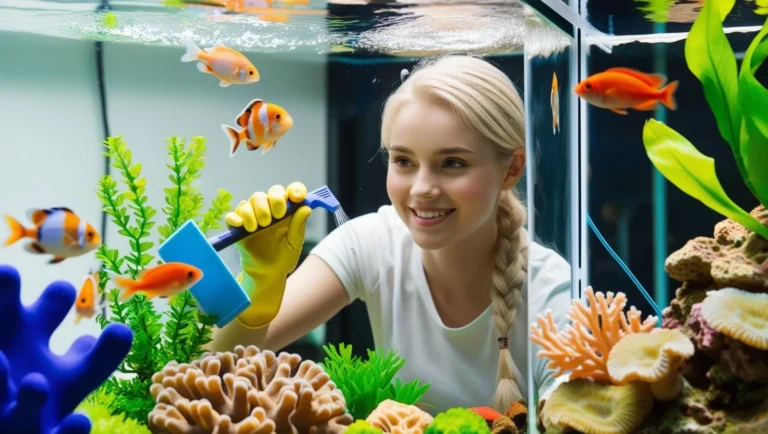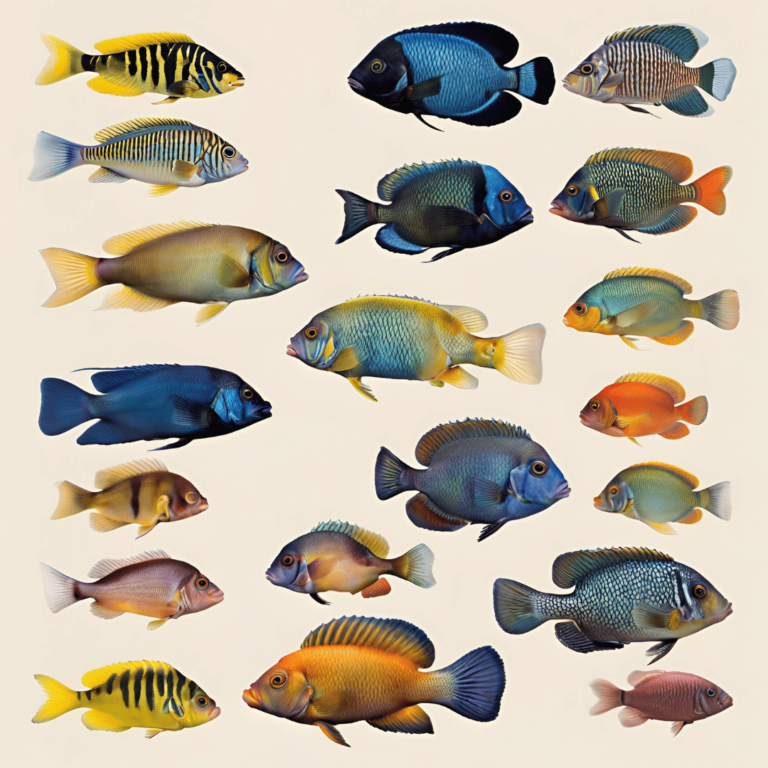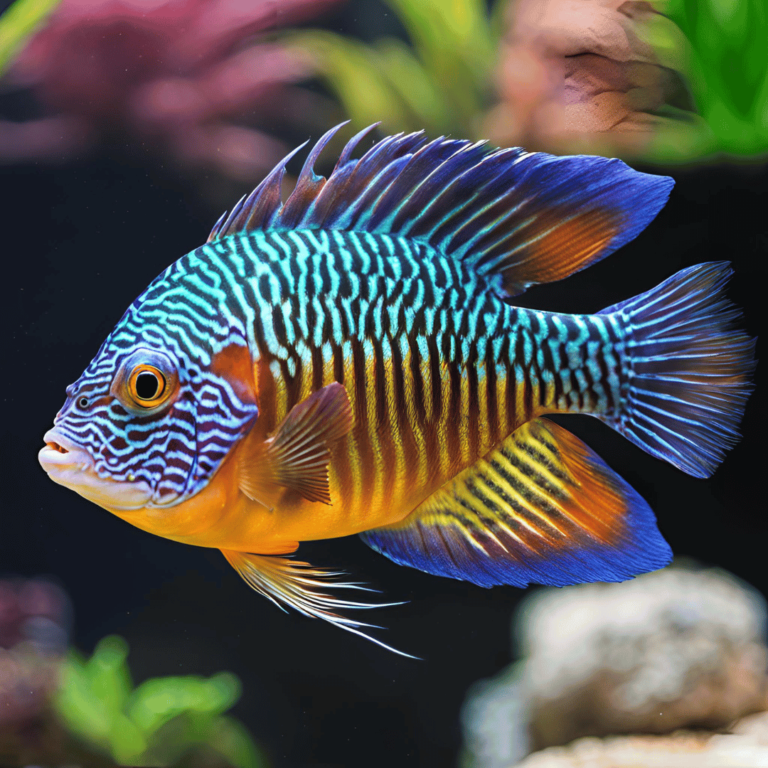Your trusted guide to cichlid care, tank setups, and quality products.

7 Expert Tips to Maintain Water Quality for Peacock Cichlids
Ensure pristine water quality for your peacock cichlids with our ultimate guide! Discover essential parameters, testing methods, and effective maintenance techniques. Create a healthy and thriving environment for your fish.
Image credits Canva
Peacock cichlids are renowned for their vibrant colors and dynamic personalities, making them a top choice for aquarists. However, ensuring they remain healthy and display their stunning hues requires exceptional water quality. In this ultimate guide, we delve into how to maintain water quality for peacock cichlids, focusing on ideal parameters, filtration, water changes, and more. Follow these 7 expert tips to keep your tank pristine and your fish thriving.
At PeacockCichlid.com, we believe in transparency and honesty with our readers. Some of the links in this article are affiliate links, which means we may earn a small commission if you make a purchase through them—at no additional cost to you. These commissions help support our site, allowing us to continue providing expert advice, in-depth guides, and valuable content for Peacock Cichlid enthusiasts like you.
We only recommend products that we trust and believe will be beneficial for your aquarium. Thank you for your support!
Why Water Quality Is Vital for Peacock Cichlids
Maintaining proper water quality is essential for the health and longevity of peacock cichlids. Poor conditions can lead to stress, diseases, dull colors, and even fatalities. These fish originate from Lake Malawi, where the water is pristine, slightly alkaline, and stable. To replicate their natural habitat and ensure proper water quality for peacock cichlids, you need to pay close attention to water parameters. A healthy environment fosters vibrant colors and active behavior.
Peacock cichlids thrive when their water mimics the stability and cleanliness of Lake Malawi. Without proper care, their immune systems weaken, making them susceptible to infections and parasites. The connection between water quality and your fish’s health cannot be overstated. Vibrant coloration, active swimming, and overall vitality all hinge on maintaining exceptional water quality for peacock cichlids.
1. Ideal Water Parameters for Peacock Cichlids
To ensure your peacock cichlids thrive, aim for these specific water parameters:
- Temperature: 76°F to 82°F. Stability reduces stress and supports metabolism.
- pH Levels: Maintain a pH between 7.8 and 8.6 to mimic Lake Malawi’s slightly alkaline conditions.
- Water Hardness: Target 8 to 12 dGH to support their natural needs.
- Ammonia, Nitrite, and Nitrate Levels: Ammonia and nitrite should be at 0 ppm, while nitrate should remain below 20 ppm.
Regular testing ensures these parameters remain consistent and conducive to your peacock cichlids’ health. Proper water quality for peacock cichlids ensures their well-being and vibrant coloration. Use high-quality heaters, pH stabilizers, and water conditioners to maintain these levels. Remember, consistency is key—sudden fluctuations can stress your fish.
When setting up your aquarium, invest in reliable thermometers and test kits to keep water quality for peacock cichlids at optimal levels. Consistent readings and adjustments will create a stress-free environment where your fish can flourish.
2. Filtration Systems for Peacock Cichlids
Filtration is a cornerstone of maintaining water quality for peacock cichlids. These fish produce substantial waste, making a robust filtration system indispensable.
- Mechanical Filtration: Removes debris and solid waste.
- Biological Filtration: Supports beneficial bacteria that process harmful substances like ammonia and nitrites.
- Chemical Filtration: Utilizes activated carbon or other media to eliminate toxins and impurities.
For a peacock cichlid tank, a canister or hang-on-back filter is ideal. Ensure regular cleaning to maintain efficiency without harming beneficial bacteria. Filters should handle at least four times the tank volume per hour to accommodate the high bio-load of peacock cichlids.
Advanced filtration systems with multi-stage filters are highly recommended for maintaining exceptional water quality for peacock cichlids. By combining mechanical, biological, and chemical filtration, you can ensure that your tank remains pristine.
3. Regular Water Changes for Optimal Quality
Frequent water changes are crucial to prevent the buildup of harmful chemicals and stabilize water conditions. Maintaining clean water is key to achieving optimal water quality for peacock cichlids.
- Frequency: Change 20-30% of the water weekly.
- Dechlorination: Treat tap water with a dechlorinator to neutralize chlorine and chloramine before adding it to the tank.
Routine water changes dilute toxins and create a clean, stable environment for your fish. Additionally, using a gravel vacuum during water changes will help remove detritus and uneaten food, ensuring a healthier tank.
The importance of water changes cannot be overstated. Consistent water quality for peacock cichlids leads to healthier fish with enhanced coloration and activity levels. Set a schedule and stick to it to maintain your aquarium’s ecosystem.
4. Monitoring and Troubleshooting Water Quality for Peacock Cichlids
Regular testing helps identify potential issues early, allowing for prompt corrective actions.
- Essential Testing Kits: Invest in kits to measure pH, ammonia, nitrite, and nitrate levels. Test weekly for best results.
- Signs of Poor Water Quality: Watch for behaviors like hiding, gasping for air, or faded colors. Perform immediate water tests and address any irregularities with water changes or filtration adjustments.
Advanced aquarists may also consider using automated testing systems for real-time water monitoring. These systems provide immediate feedback, ensuring you catch issues before they escalate. Consistent monitoring is the backbone of maintaining pristine water quality for peacock cichlids.
5. Maintaining Stability in Water Parameters for Peacock Cichlids
Stability is critical for peacock cichlids, as sudden changes can lead to stress or health problems.
- Use a heater to ensure consistent temperatures.
- When adjusting pH or hardness, make gradual changes.
- Employ buffering solutions to stabilize pH levels if needed.
By keeping conditions stable, you reduce stress and foster a thriving tank environment. Regular maintenance schedules and monitoring tools can significantly reduce the likelihood of abrupt changes. Stability in water quality for peacock cichlids is paramount to their overall health.
6. The Role of Plants and Decorations in Maintaining Water Quality
Adding live plants to your tank can enhance water quality by absorbing excess nutrients. However, select hardy species, as peacock cichlids may dig or uproot delicate plants.
- Decorations: Choose items made from non-toxic materials like resin or smooth stones. Avoid sharp objects or items that can leach harmful chemicals into the water.
- Benefits: Proper decorations and plants contribute to water quality for peacock cichlids by reducing toxins and providing a more natural habitat.
When selecting plants, consider species like Java fern or Anubias, which are durable and require minimal maintenance. Thoughtful tank design can significantly improve water quality for peacock cichlids while creating a visually appealing environment.
7. Bonus Tips for Crystal-Clear Water
- Avoid Overfeeding: Excess food can decompose and affect water quality.
- Quarantine New Fish: Prevent diseases by isolating new fish for observation before adding them to the tank.
- Maintain Proper Stocking Levels: Overstocking can overwhelm your filtration system and degrade water quality.
- Aeration: Ensure sufficient oxygen levels with air pumps or surface agitation to improve water quality.
- UV Sterilizers: Use UV sterilizers to control algae and harmful microorganisms.
Bonus tips like these go a long way in ensuring pristine water quality for peacock cichlids. A proactive approach can save you time and stress while keeping your fish happy and healthy.
Conclusion: Achieve Pristine Water Quality for Your Peacock Cichlids
Maintaining water quality for peacock cichlids is key to showcasing their beauty and ensuring their health. By focusing on optimal parameters, robust filtration, and regular maintenance, you create a thriving aquatic environment. Regular monitoring, attention to stability, and mindful decoration choices further enhance their habitat.
Have your own tips or experiences with peacock cichlid care? Share them in the comments below! Don’t forget to share this guide with fellow aquarists to help everyone keep their cichlids happy and healthy.
If you found these water quality tips helpful, why not explore more of our expert advice on peacochcichlid.com? For additional strategies to keep your aquarium balanced, check out Peacock Cichlid pH Stability: 10 Powerful Steps for Success and learn comprehensive care routines with Peacock Cichlid Tank Maintenance: 14 Proven Tips for Success. You can also dive into practical cleaning methods in Peacock Cichlid Tank Cleaning: 7 Best Tools & Expert Tips or avoid common pitfalls by reading Top 10 Mistakes to Avoid When Keeping Peacock Cichlids.
We’re dedicated to helping you create the ideal environment for your Peacock Cichlids, so be sure to visit us again for more tips and updates, and follow us on social media for the latest insights and trends in aquarium care!
FAQ’s
What is the ideal water temperature for peacock cichlids?
The ideal water temperature for peacock cichlids ranges between 76°F and 82°F. Maintaining this temperature consistently is crucial for ensuring proper water quality for peacock cichlids and other similar species.
How often should I test the water quality for peacock cichlids?
It’s best to test the water quality for peacock cichlids weekly. Regular testing helps ensure stable parameters and allows you to address any potential issues before they affect your fish.
Can poor water quality impact the colors of my peacock cichlids?
Yes, poor water quality for peacock cichlids can lead to dull colors and stress. Clean, stable water replicating their natural habitat enhances their vibrant hues and overall health.
Do peacock cichlids require a specific pH level in their water?
Yes, peacock cichlids thrive in slightly alkaline water with a pH level between 7.8 and 8.6. Consistently maintaining this range is vital for optimal water quality for peacock cichlids and other Lake Malawi cichlids.
How can I improve water quality for peacock cichlids without frequent water changes?
Using a high-quality filtration system and live plants can help maintain water quality for peacock cichlids. However, regular water changes remain essential to prevent toxin buildup.
What type of filtration system is best for peacock cichlids?
A canister or hang-on-back filter works well for peacock cichlids. Look for a system that provides mechanical, biological, and chemical filtration to support excellent water quality for peacock cichlids and other high-waste fish.
Can overfeeding affect the water quality for peacock cichlids?
Absolutely. Overfeeding leads to excess food decomposing in the tank, which can degrade the water quality for peacock cichlids. Feed them only what they can consume in a few minutes.
Is it safe to use tap water for peacock cichlids?
Tap water is safe for peacock cichlids as long as you treat it with a dechlorinator to neutralize chlorine and chloramine. Properly conditioned water ensures stable water quality for peacock cichlids.
How do I maintain stable water parameters for peacock cichlids during seasonal changes?
Using a reliable aquarium heater and monitoring pH levels can help maintain stable water quality for peacock cichlids year-round, even during temperature fluctuations.
Can other cichlids thrive in the same water conditions as peacock cichlids?
Yes, many Lake Malawi cichlids share similar water requirements. Maintaining optimal water quality for peacock cichlids will also benefit other cichlids in your tank with similar needs.



